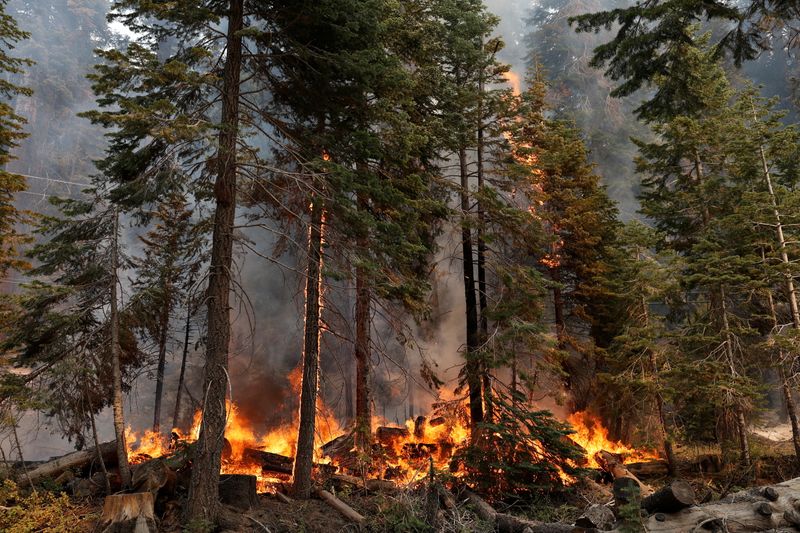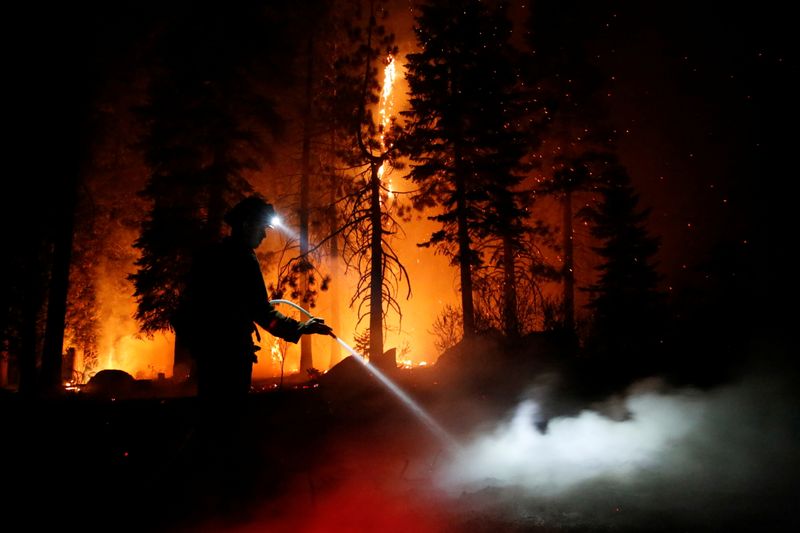By Fred Greaves
SOUTH LAKE TAHOE, Calif. (Reuters) -South Lake Tahoe stood smoke-filled and largely deserted on Wednesday after crews fought back a huge, wind-driven wildfire, leaving the California resort town unscathed as flames crept on toward Nevada.
U.S. President Joe Biden approved a declaration of emergency in California and ordered federal assistance to boost local responders' efforts to battle the Caldor fire, the White House said.
Biden's action authorized co-ordination of disaster relief measures by the Department of Homeland Security and Federal Emergency Management Agency (FEMA), the White House added.
The Caldor fire, burning since mid-August in the Sierra Nevada range, still threatened homes and businesses near Lake Tahoe, abetted by gusty, bone-dry conditions.
But forecasts called for winds to significantly subside Thursday and Friday, giving firefighters a chance to make more headway and consolidate their gains.
"Over the next couple of days, we're going to see the weather change, and we're going to see the fire behavior slacken ... to the point where we can actually get in there and do some good work," Steve Volmer, a fire behavior analyst with the California Department of Forestry and Fire Protection (Cal Fire), told a community briefing on Wednesday evening.
South Lake Tahoe, the biggest town along the rim of North America's largest alpine lake in a region renowned as an outdoor recreational hub and world-class ski area, had appeared to be in grave danger 24 hours earlier.
Its 22,000 residents were ordered to evacuate on Monday - fleeing in a major traffic jam - after flames unexpectedly crested a ridgeline and swept downs toward communities in the lake's basin.
Over the next two days, firefighters waged an all-out battle to save South Lake Tahoe and nearby communities, including the smaller, unincorporated village of Meyers, a former trading post and Pony Express station.
By Wednesday morning, they had "steered the fire away," Jason Hunter, a spokesman for the Caldor incident command, told Reuters by telephone.
Hunter said the wind's direction late on Tuesday through Wednesday morning had helped push flames to the northeast rather than straight north toward Lake Tahoe, which straddles the California-Nevada border.
"There was a massive amount of heavy-equipment work and structure-protection work along those neighborhoods," he said.
"We're not out of the woods yet," but crews kept the fire "outside those communities and away from homes," Cal Fire spokesman Henry Herrera told Reuters by telephone.
Firefighters also got help on Wednesday morning from an atmospheric inversion layer that settled over the Tahoe area overnight, trapping smoke close to the ground and tamping down flames at lower elevations, officials said.
MASS EVACUATIONS
In all, Caldor has forced an estimated 50,000 people to flee and destroyed at least 729 structures, most of them single-family dwellings, while 34,800 more buildings were listed as threatened throughout the fire zone, Cal Fire said.
As of Wednesday morning, the fire had charred more than 204,000 acres (82,500 hectares) of drought-parched timber, some 4,700 acres (1,900 hectares) more than reported the night before.
Ground crews hacking away vegetation with bulldozers and hand tools had carved containment lines around 20% of the fire's perimeter as of Wednesday, Cal Fire said, up from 15% containment on Tuesday morning.
The Caldor fire was among nearly two dozen raging across California and scores of others elsewhere in the West, during a summer fire season shaping up as one of the most destructive on record. The blazes have been stoked by extremely hot, dry conditions that experts say are symptomatic of climate change.
While winds were expected to abate, extremely low humidity remained in the forecast.
As the fire raged closer to the Nevada state line, officials expanded the area under evacuation orders to include more of California's sparsely populated Alpine County, on the border.
Authorities across the state line in Douglas County, Nevada, warned residents to be ready to flee at a moment's notice.
'UNSTOPPABLE'
Gazing at a U.S. Forest Service map outside a Red Cross shelter in Carson City, Nevada, on Tuesday, evacuee Lee England, 47, a hip-hop skate performer and instructor, recalled the dread she felt before fleeing her South Lake Tahoe apartment late on Sunday.
“We could see the tip of red and deep dark gray. We knew right away things were in bad shape,” she said, and recalled thinking, "this thing is just unstoppable."
The smell of smoke hung in the air in Carson City, the Nevada state capital, about 30 miles (48 km) east of Tahoe. When a bit of ash fell on the back of England’s Boston terrier, Bon Bon, she bent and gently plucked the gray fleck from the black and white fur.
Nearly 4,200 personnel and a squadron of over two dozen water-dropping helicopters were assigned to the blaze. The cause is being investigated.

No deaths have been reported but three firefighters and two civilians were injured in recent days.
During an operational briefing for firefighting personnel on Wednesday, the team's safety officer warned that "fatigue can and will set in," and urged crews to pace themselves for what remained a long, arduous battle.
